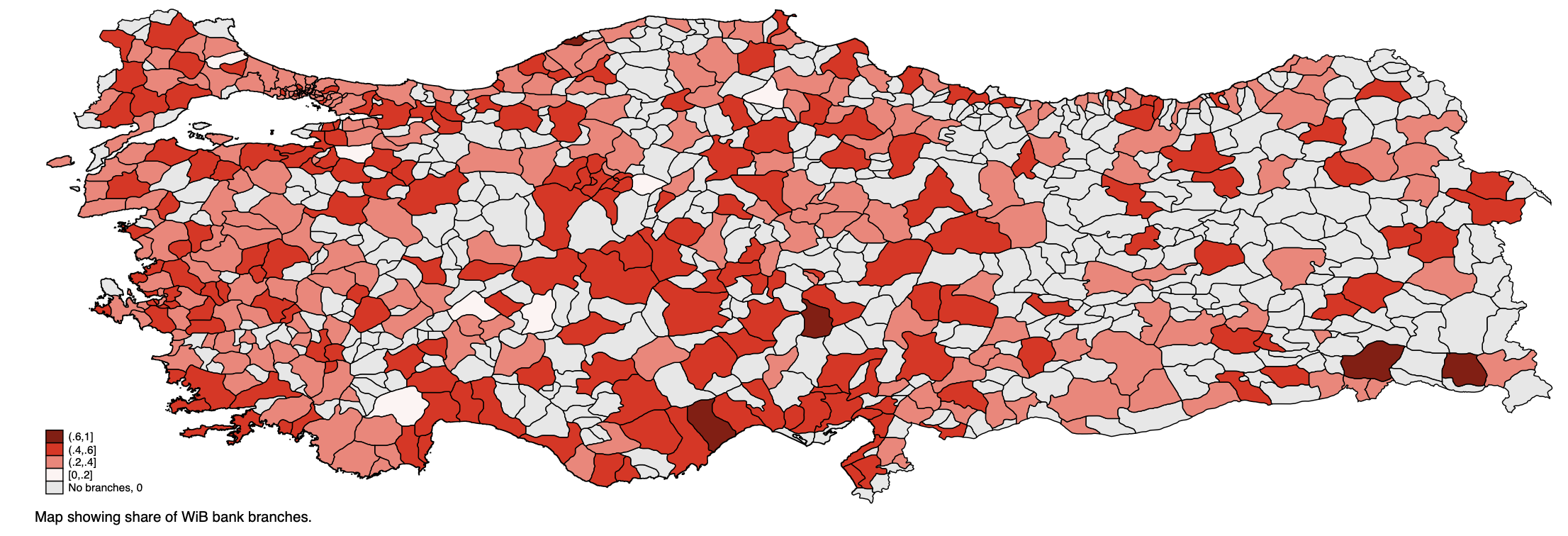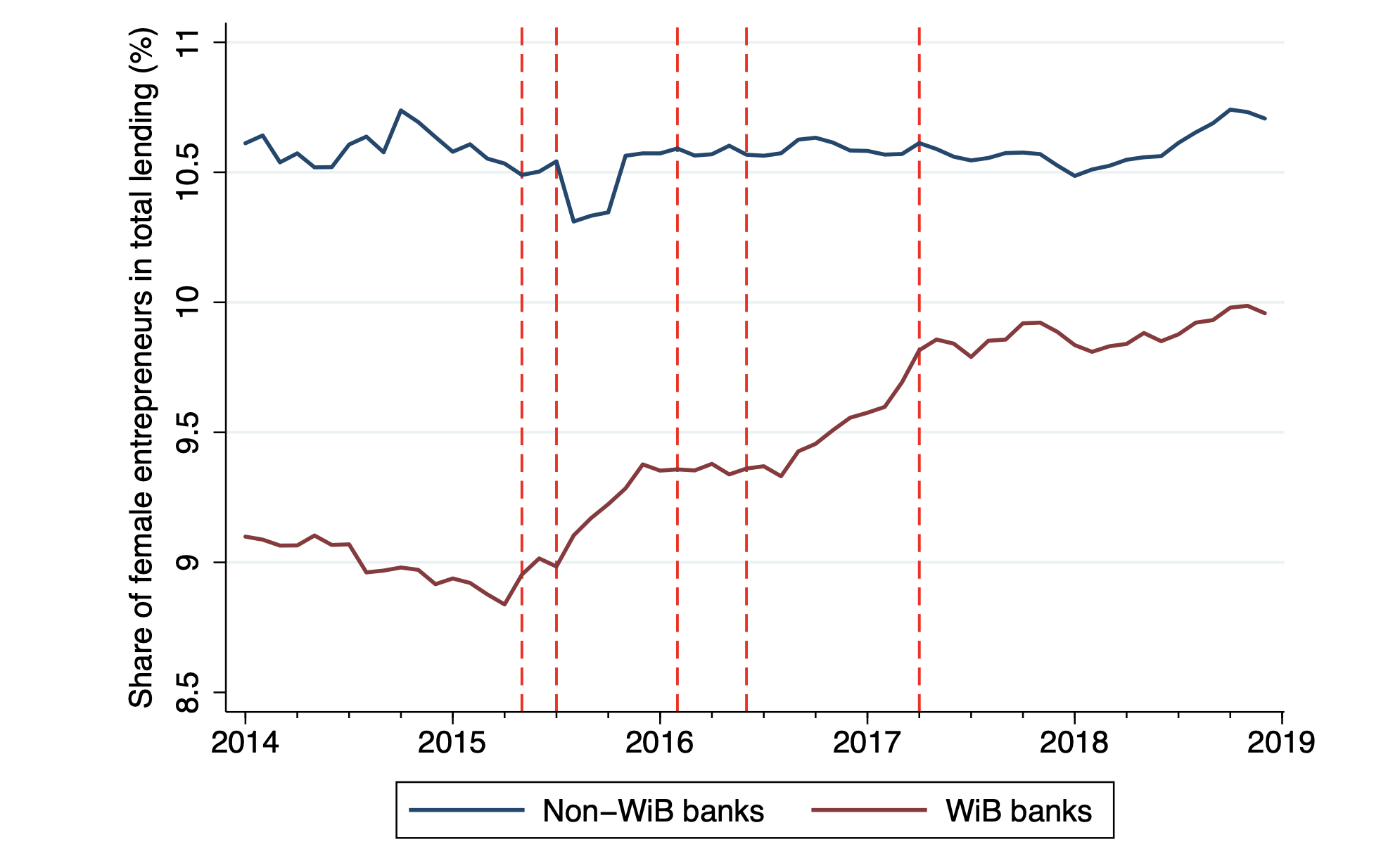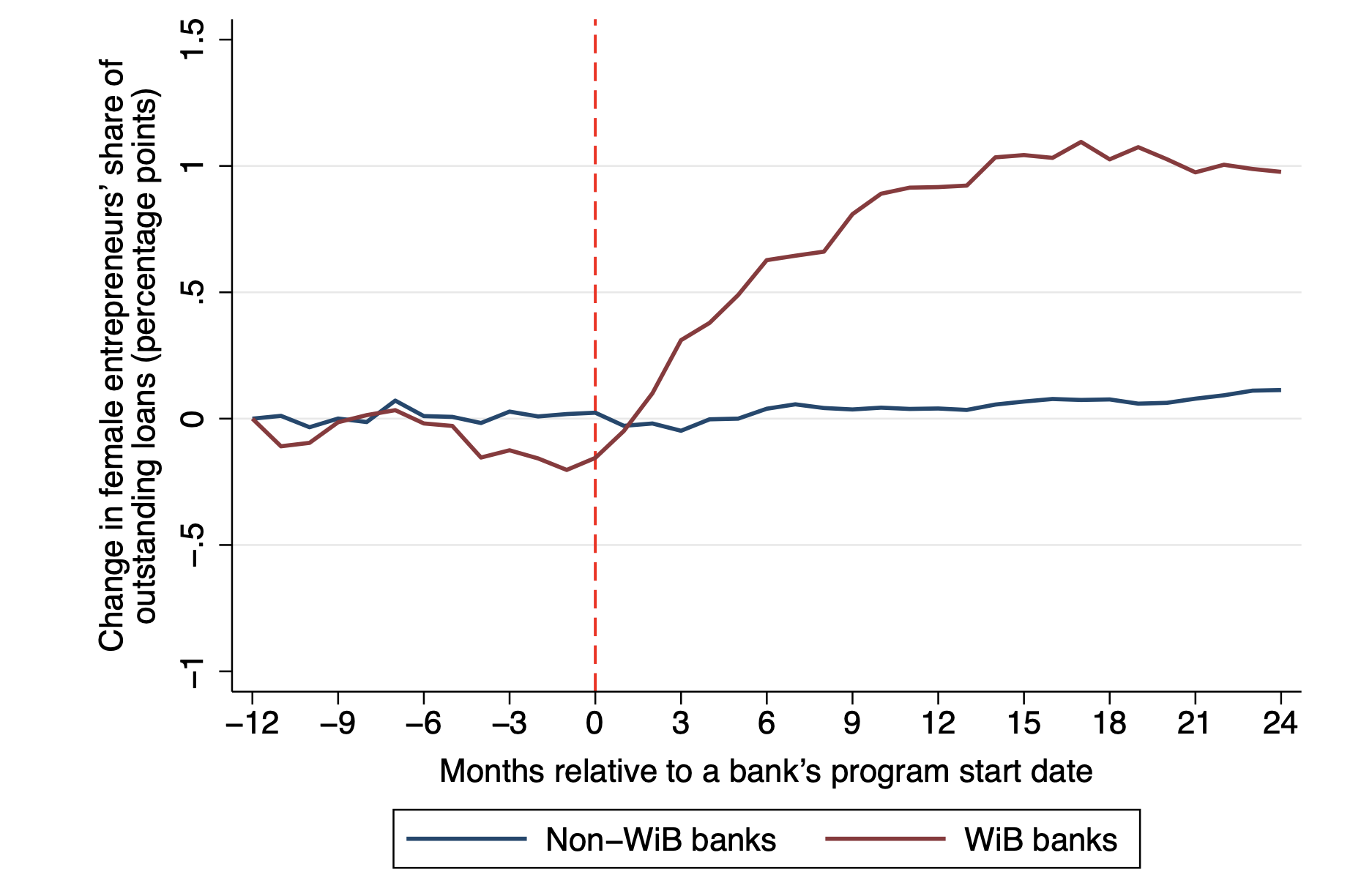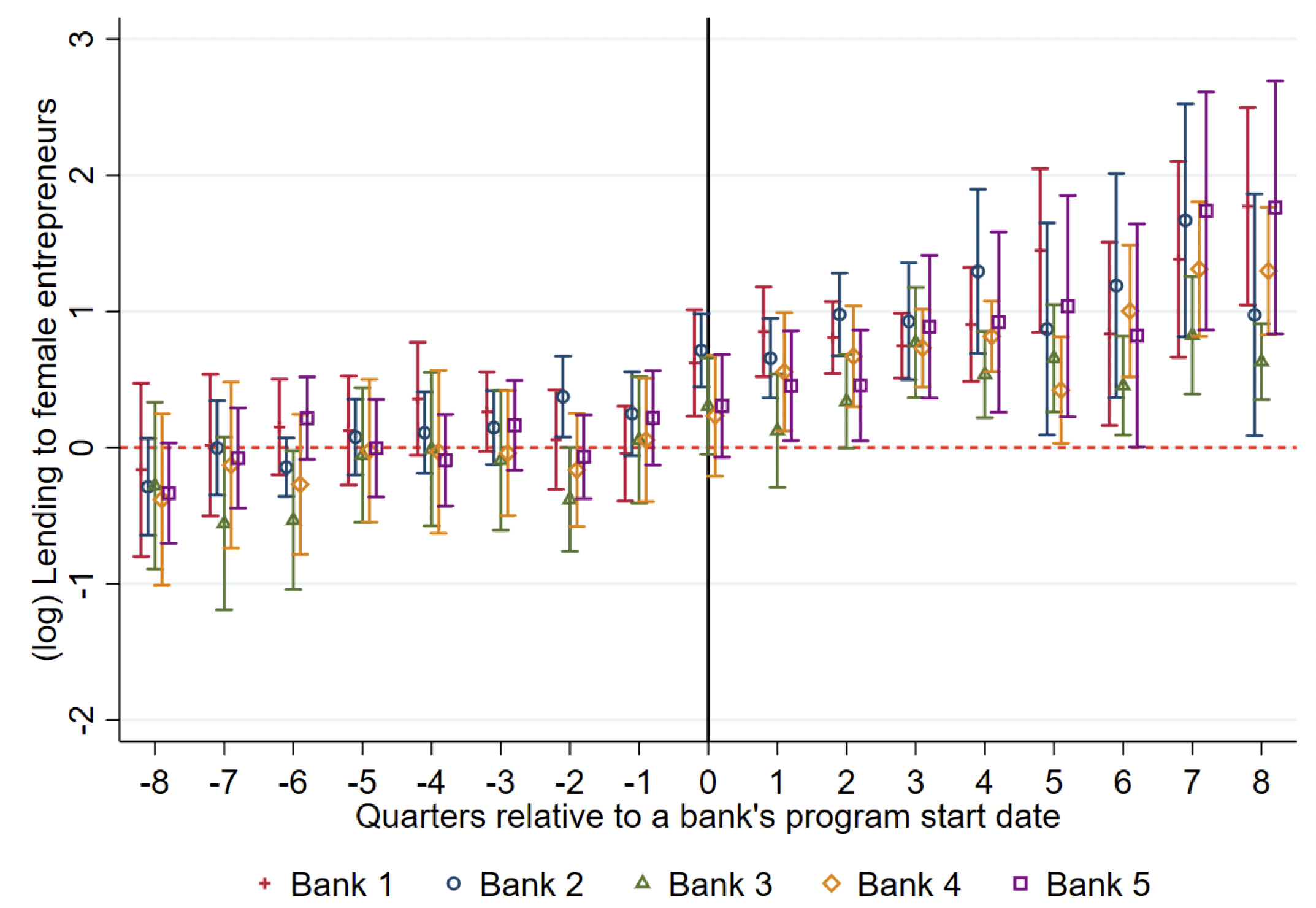Female entrepreneurs often encounter greater challenges in securing funding compared to their male counterparts (Klapper and Parker 2011, Nanda and Howell, 2020). This disparity can be attributed to various factors, including biased loan officers (Alesina 2008, Brock and De Haas 2023), restrictive gender norms, and discriminatory legal arrangements. The resulting frictions may impede the growth and productivity of businesses run by women. Several countries have therefore initiated blended finance programmes for female entrepreneurs, with the goal of creating a more equitable financial landscape.
In a typical blended finance programme, a development finance institution provides private banks with loans containing a use-of-proceeds clause. These banks then pool (‘blend’) this public finance with commercial funding of their own, and on-lend the combined funds to the type of borrowers specified in the use-of-proceeds clause. Two other elements are common. The first is technical assistance to banks, such as for staff training and IT upgrading. The second is risk sharing via a partial credit guarantee by the development finance institution or a third party.
Recent examples of blended finance programs for female entrepreneurs include the Women Entrepreneurs Opportunity Facility by the International Finance Corporation (IFC) (US$4.5 billion); the Banking on Women programme, also by the IFC ($3 billion); the Affirmative Finance Action for Women in Africa by the African Development Bank ($1.3 billion); the SheInvest programme by the European Investment Bank ($2 billion); and the Women Entrepreneurship Banking programme by the Inter-American Development Bank ($0.8 billion).
The Women in Business programme
In a recent paper (Aydin et al. 2024), we aim to establish whether and how blended finance programmes help targeted firms to borrow and grow. Our focus is on the Women in Business (WIB) programme for female entrepreneurs in Türkiye. This programme was rolled out through five Turkish banks during 2014–2019 with the goal of stimulating these banks to lend more to women-run small businesses. The programme comprised three components: public credit lines to five banks for a total of €300 million, a risk-mitigation mechanism in the form of a first-loss risk cover (FLRC) that guaranteed up to 10% of each participating bank's portfolio, and technical assistance. The latter involved tailored consultancy packages that included classroom training on gender-responsive sales, online training for loan officers on gender awareness and overcoming behavioural constraints, and support in developing new financial products and procedures that cater to women entrepreneurs.
Banks had to blend the credit lines with their own funding and, by the end of 2017, a total of €417 million had been disbursed to more than 12,000 female-run small businesses. Figure 1 shows the district-level market shares of the participant banks as measured by their branch presence in 2014.
Figure 1 Pre-programme market share of branches operated by treated banks
Notes: This district-level map of Turkey shows for each district the share of bank branches that are operated by treated banks as of end-2014.
Because banks received the programme funding at different points in time, they started to disburse sub-loans at different times as well. The vertical red lines in Figure 2 indicate these staggered start dates, a feature that we exploit to measure programme impact. The graph also shows a gradual and partial closing of the gap between treated banks (those partaking in the blended finance programme) and other (control) banks in terms of the gender composition of their portfolio of small business loans. This is some first descriptive evidence on the bank-level impact of the programme.
Figure 2 Staggered roll-out of the blended finance programme and the share of lending to female entrepreneurs
Notes: This figure shows total outstanding loans to female entrepreneurs as a percentage of the total outstanding stock of loans to all entrepreneurs for treated (WiB) banks in red and non-treated (non-WiB) banks in blue. The vertical dashed lines indicate when each of the five treated banks disbursed their first loan as part of the WiB blended finance program: May 2015, July 2015, February 2016, June 2016, and April 2017.
Data and methodology
The main dataset we use is the Turkish credit registry, which allows us to track firms' borrowing over time and across lenders, and gauge their risk profile based on credit history and repayment performance. These data are merged with various firm-level administrative records from the Ministry of Treasury and Finance. Using these data, we aim to answer three questions. First, can blended finance durably increase bank lending to female entrepreneurs? Second, which female-owned businesses (if any) gain better access to credit? Third, what are the real-economic impacts (if any) on these firms?
To identify programme effects, a two-way fixed effect model is built around the staggered programme introduction. Because of the by now well-known pitfalls of two-way fixed effects estimators when treatment effects vary across units and time, a ‘stacking’ difference-in differences methodology is used. We also apply a synthetic difference-in-differences estimator, which creates a synthetic control bank for each of the five banks in the programme.
The impact of the blended finance programme on participating banks
Figure 3 shows that before banks entered the blended finance programme, to-be-treated banks (auburn line) and control banks (blue line) were on similar trajectories in terms of the gender composition of their small business loans. Once banks got access to blended finance, at time 0, they started to allocate more credit to female-run firms (auburn line). Nothing changes for control banks (blue line).
Figure 3 Change in the share of lending to female entrepreneurs around WIB entry
Notes: This figure shows the average bank-level change in the share of female entrepreneurs in the stock of outstanding loans to all entrepreneurs before and after banks start participating in the programme. For each of the five treated banks, we normalize the month in which the bank disbursed its first loan as part of the programme to 0. For banks that never participated in the program, we use their monthly observations corresponding to the normalized time scale for each participant bank. We then calculate the average share of lending to female entrepreneurs in each month, relative to the start of the program, for participant banks and for non-participant banks separately.
Further analysis of the micro data confirms that the blended finance programme durably increased lending to female entrepreneurs – both in absolute terms and relative to male-owned firms. Participating banks expand new loan issuance to female entrepreneurs much faster than control banks (Figure 4 shows this for each of the five treated banks). More specifically, treated banks increased the share of all business lending allocated to women by 2 percentage points on average. This is an economically meaningful effect (an increase of 22%), given that treated banks allocated only around 9.0% of their total lending to female entrepreneurs in 2014. Over time, programme impacts do not mean revert but settle at a higher steady state for each of the treated banks, although treatment effects are heterogeneous in terms of size and dynamics (as can again be seen in Figure 4).
Figure 4 Blended finance and lending to female entrepreneurs: Event-study estimates based on synthetic difference-in-differences
Notes: This figure shows estimates for each individual WiB bank in an event-study set-up using the synthetic difference-in-differences methodology of Arkhangelsky et al. (2021). The dependent variable is (log) total loan volume to female entrepreneurs. Error bands show 95% confidence intervals.
Who benefited? The data show that the blended finance programme helped banks to lend more to their existing female clients. This accounts for about 50% of the increase in the share of lending allocated to women. The other half reflects lending to new borrowers: 31% of the increased lending is to female borrowers poached from other lenders and 19% is to firms that had never previously borrowed from any bank. In short, the programme expanded credit to existing borrowers that were still credit-constrained (intensive margin) while also crowding in new female borrowers (extensive margin).
Did loan quality suffer?
A comparison of female first-time borrowers who received their first loan from a treated bank with those borrowing for the first time from a control bank reveals no evidence that the blended finance programme undermined credit quality. First-time female borrowers are equally likely to default – either on bank credit or on debts to suppliers – irrespective of whether they borrow from a treated or control bank. They are also as likely to receive a follow-up loan from their first lender or, in contrast, to leave that bank in the medium-term.
The impact of access to blended finance on female-run businesses
An important question is whether the positive credit supply shocks caused by the blended finance programme helped female-owned firms perform better. This turns out to be the case: a 10% increase in the supply of bank credit to a female entrepreneur due to the WIB programme resulted in an increase in investment of 1.3%. Firms also increase their sales and profits by on average 1.3% and 8.2%, respectively, due to this positive credit shock. Combined, these impacts ensure that beneficiary firms are 2.4 percentage points more likely to remain in business one year after the start of the programme. Importantly, not all firms benefited equally from the programme: those that initially had a higher capital productivity borrow and invest more. This suggests that the programme was effective in helping to improve the allocation of capital across small and medium-sized firms.
Conclusions
Blended finance programmes bundle liquidity support, comprehensive training, and risk sharing. The analysis summarised in this column indicates that this can be an effective approach to motivate and enable banks to lend more to underserved business segments.
A large part of the programme impact occurred on the intensive margin. A higher (temporary) first-loss risk cover might help to entice banks to expand their lending to new female borrowers even more. Another option to strengthen programme impact (other than scaling up) would be to introduce performance-based incentives. Participating banks then receive an interest discount on their credit lines that is conditional on achieving specific goals at the portfolio level, such as a higher share of female borrowers among all clients or among all first-time clients. Such high-powered incentives, applied temporarily and phased out over time, may help to further shift bank lending towards underserved target segments in a profitable and durable way.
References
Alesina, A (2008), “Are Women Discriminated Against in Credit Markets in Italy?”, VoxEU.org, 30 September.
Aydın, H, Ç Bircan, and R De Haas (2024), “Blended Finance and Female Entrepreneurship”, CEPR Discussion Paper No. 18763.
Brock, J M and R De Haas (2023), “Discriminatory Lending: Evidence from Bankers in the Lab”, American Economic Journal: Applied Economics 15(2): 31-68.
Klapper, L F and S C Parker (2011), “Gender and the Business Environment for New Firm Creation”, World Bank Research Observer 26(2): 237-257.
Nanda, R and S Howell (2020), “Networking Frictions in Venture Capital and the Gender Gap in Entrepreneurship”, VoxEU.org, 29 February.









